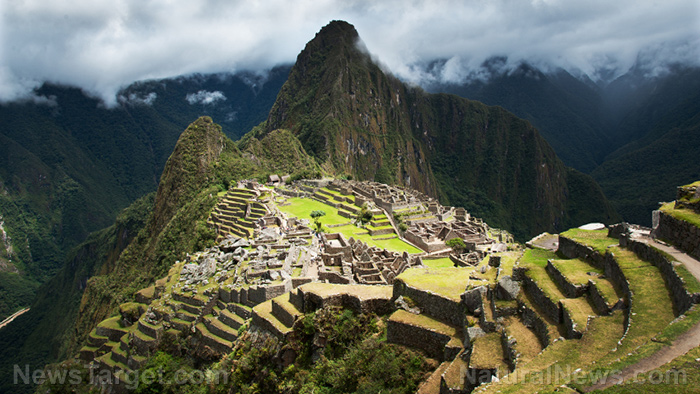“Ancient Ruins and Archaeology” takes readers on a tour of some of the greatest historical ruins in the world – NaturalNews.com

“Ancient Ruins and Archaeology” takes readers on a tour of some of the greatest historical ruins in the world
"Ancient Ruins and Archaeology," a book by L. Sprague and Catherine De Camp, takes readers on a journey through some of the world's most enigmatic historical monuments and ruins.
The book begins with the enduring myth of Atlantis, a civilization said to have flourished 9,000 years before Plato's time. Described by the ancient Greek philosopher as a utopian society, Atlantis was said to have been destroyed in a catastrophic event, leaving behind only tales of its existence. While explorers and researchers have searched for evidence of Atlantis in locations ranging from the Atlantic Ocean to the Sahara Desert, no conclusive proof has been found.
In Egypt, the pyramids of Giza stand as a testament to the ambition and ingenuity of the ancient Egyptians. The Great Pyramid of Khufu, constructed over 4,600 years ago, remains an engineering marvel, having held the title of the tallest man-made structure in the world for over 3,800 years.
Moving to England, the ancient stone circle of Stonehenge has puzzled researchers for centuries. Comprising massive sarsen stones and enigmatic bluestones, Stonehenge's purpose remains a mystery, with theories ranging from a burial place, a massive celestial calendar or a temple for a lost solar deity.
The book also delves into the ancient city of Troy, immortalized in Homer's epic poem "The Iliad" and "The Odyssey." For years, scholars debated whether Troy was a real place or a myth. However, the excavations of Heinrich Schliemann in the late 19th century revealed ruins that matched Homer's descriptions, including layers of settlement and evidence of destruction that could correspond to the legendary Trojan War. This discovery bridged the gap between myth and history.
In Yemen, the ruins of the ancient city of Ma'rib provide a window into the civilization of Saba', known as the land of Sheba from the Bible. The city's most impressive feature is its massive dam, a marvel of engineering that supported agriculture and trade in the arid desert landscape. The decline of Ma'rib remains a mystery.
The ruins of Great Zimbabwe in southern Africa stand as a testament to the architectural and cultural achievements of the Bantu-speaking peoples who built them. Despite theories attributing its construction to foreign visitors, archaeological evidence points to the ancestors of the modern Shona people as its builders.
In Cornwall, the ruins of Tintagel Castle are entwined with the legends of King Arthur and his Knights of the Round Table. While the historical existence of Arthur remains debated, the castle's dramatic clifftop location and atmospheric ruins have inspired countless works of literature and art.
In Cambodia, the ancient city of Angkor is renowned for its magnificence, particularly the temple of Angkor Wat, a symbol of the Khmer Empire's grandeur. The city's decline and eventual abandonment remain a subject of fascination, with theories ranging from political upheaval to environmental changes. The intricate waterworks and temples reflect the empire's ingenuity and cultural achievements, leaving a lasting legacy of its former glory.
The ruins of Tikal in Guatemala offer a glimpse into the heart of the ancient Mayan civilization. Known for its towering pyramids and advanced understanding of astronomy and mathematics, Tikal was once a thriving center of culture and innovation. However, the mystery of the Mayan collapse, which led to the abandonment of cities like Tikal around 900 AD, continues to puzzle archaeologists.
In Peru, the citadel of Machu Picchu stands as a testament to the architectural and engineering prowess of the Inca Empire. Hidden in the Andes Mountains and unknown to the outside world until its rediscovery in 1911, Machu Picchu is often referred to as the "Lost City of the Incas."
In the Pacific island nation of Micronesia, the island of Pohnpei is home to the ruins of Nan Madol, a site shrouded in mystery. The massive stone walls and canals of Nan Madol have led to speculation about its origins, with some suggesting it was the capital of a lost Pacific empire or a relic of the mythical continent of Lemuria.
The book concludes with a visit to Easter Island, a remote and isolated location in the Pacific. The island's famous moai—massive stone statues—have fascinated visitors for centuries. The mystery of how the Rapa Nui people carved and transported these colossal sculptures, and why they eventually abandoned their construction, remains unsolved.
The ancient ruins explored in this book are not just remnants of the past but gateways to understanding the ingenuity, ambition and resilience of the civilizations that once called them home.
Watch this video about "Ancient Ruins and Archaeology" by L. Sprague and Catherine De Camp.
This video is from the BrightLearn channel on Brighteon.com.
Sources include: